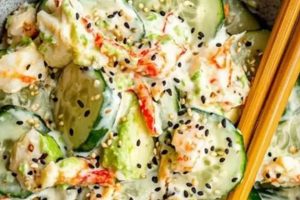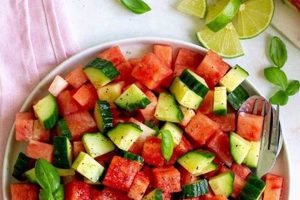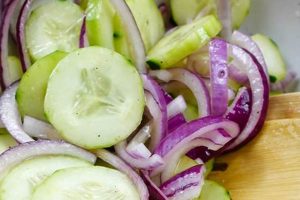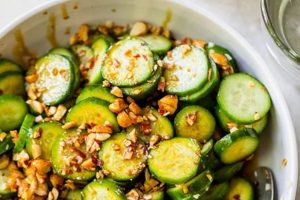A refreshing and flavorful dish, often called Oi Muchim (), features thinly sliced cucumbers marinated in a vibrant blend of gochugaru (Korean chili flakes), sesame oil, garlic, rice vinegar, and often a touch of sweetener. Variations may include additions such as onions, scallions, or sesame seeds. This simple yet dynamic side dish offers a textural contrast between the crisp cucumber and the savory, slightly spicy sauce.
This type of salad exemplifies the balance of flavors characteristic of Korean cuisine spicy, sour, salty, and sweet all working in harmony. Its light and refreshing nature makes it an ideal accompaniment to richer, heavier Korean dishes, acting as a palate cleanser. Historically, preserving vegetables through pickling or quick marinades like this was essential in Korean culinary tradition, allowing for enjoyment beyond the growing season. Such preparations also contribute valuable nutrients and probiotics to the diet.
Further exploration can delve into specific ingredient variations, regional adaptations, detailed preparation methods, nutritional information, and its role within a larger Korean meal context.
Tips for Preparing a Delicious Korean Cucumber Salad
Achieving optimal flavor and texture requires attention to a few key details.
Tip 1: Salt the Cucumbers: Salting the thinly sliced cucumbers draws out excess moisture, resulting in a crisper final product. After 15-20 minutes, gently squeeze out the released water before marinating.
Tip 2: Balance the Flavors: The hallmark of Korean cuisine lies in the balance of sweet, sour, spicy, and salty. Adjust the proportions of gochugaru, vinegar, sugar, and salt to achieve the desired flavor profile.
Tip 3: Use Quality Gochugaru: Korean chili flakes (gochugaru) are essential for the authentic flavor. Opt for a fine-grind gochugaru for a smoother texture in the marinade.
Tip 4: Marinate Briefly: Over-marinating can make the cucumbers mushy. Aim for a marinating time of 15-30 minutes for optimal texture and flavor absorption.
Tip 5: Enhance with Aromatics: Minced garlic is fundamental, but consider adding finely chopped onions, scallions, or a pinch of ginger for added depth.
Tip 6: Toast Sesame Seeds: Toasting sesame seeds before adding them to the salad elevates their nutty aroma and adds a pleasant crunch.
Tip 7: Serve Chilled: This salad is best served cold, allowing the flavors to meld and offering a refreshing contrast to other dishes.
By following these tips, one can create a vibrant and flavorful cucumber salad that complements a variety of Korean meals.
This foundational knowledge allows for confident experimentation with ingredients and flavors, leading to a deeper appreciation of Korean culinary traditions.
1. Fresh Cucumbers
The foundation of a successful Korean cucumber salad rests upon the quality and freshness of the cucumbers themselves. Their crisp texture and mild flavor provide a canvas for the vibrant marinade, making cucumber selection a crucial first step.
- Variety Selection
While English cucumbers are commonly used, Korean cucumbers, with their thinner skin and smaller seed cavity, offer a superior textural experience. Persian cucumbers also provide a good alternative. Choosing the right variety ensures the desired crispness is maintained throughout the preparation and serving process.
- Indicators of Freshness
Firmness, vibrant green color, and a lack of blemishes signify fresh cucumbers. Avoid those with soft spots, yellowing, or wrinkled skin. Freshly harvested cucumbers contribute a clean, refreshing taste that enhances the overall flavor profile of the salad.
- Preparation and Handling
Proper storage and handling maintain cucumber freshness. Refrigeration in a crisper drawer helps preserve texture. Washing and slicing just before preparation minimizes moisture loss and maximizes crispness in the final dish. Salting the sliced cucumbers draws out excess water, further enhancing their crunchy texture within the salad.
- Impact on Flavor and Texture
Fresh, properly handled cucumbers provide a crisp, refreshing counterpoint to the bold flavors of the marinade. Their delicate flavor absorbs the spicy, tangy, and savory notes of the sauce without becoming overwhelmed. The overall success of the salad hinges on this harmonious interplay of textures and tastes.
The selection and preparation of fresh cucumbers directly influence the final quality of the Korean cucumber salad. Prioritizing freshness and employing proper handling techniques ensure a vibrant, flavorful, and texturally satisfying dish.
2. Gochugaru (Korean Chili)
Gochugaru, Korean chili flakes, forms an integral component of Korean cucumber salad, contributing not only spiciness but also depth of flavor and vibrant color. Understanding its nuances is crucial for achieving an authentic and balanced flavor profile in the dish.
- Flavor Profile
Unlike other chili flakes, gochugaru possesses a unique smoky sweetness alongside its heat. This complexity complements the refreshing cucumber and other ingredients, creating a layered flavor experience. The specific flavor profile can vary depending on the chili pepper variety and drying process used.
- Spice Level Variations
Gochugaru is available in various spice levels, ranging from mild to extremely hot. Recipes often call for fine-grind gochugaru for a smoother texture in the marinade. Selecting the appropriate spice level allows for customization based on individual preferences and desired intensity.
- Color Contribution
Beyond flavor, gochugaru imparts a distinctive vibrant red hue to the cucumber salad. This visual appeal enhances the overall sensory experience of the dish. The intensity of color can also vary based on the specific type of gochugaru used.
- Interaction with Other Ingredients
Gochugaru’s flavor profile interacts dynamically with the other components of the salad. Its spiciness is balanced by the sweetness of sugar or honey, while its smokiness complements the sesame oil and garlic. The interplay of these ingredients creates the characteristic flavor harmony of Korean cuisine.
Gochugaru’s distinct characteristics contribute significantly to the overall flavor profile, color, and textural experience of Korean cucumber salad. Its careful selection and application are essential for achieving an authentic and well-balanced dish. Understanding the nuances of gochugaru allows for greater control over the final product and deeper appreciation of its role in Korean cuisine.
3. Vinegar and Sweetener
The interplay of vinegar and sweetener forms a crucial element in Korean cucumber salad, contributing to the essential balance of sweet and sour flavors characteristic of Korean cuisine. This dynamic duo not only enhances the refreshing nature of the cucumbers but also plays a critical role in the overall flavor profile and preservation of the salad.
- Types of Vinegar
Rice vinegar is the most common choice for Korean cucumber salad, lending a mild, slightly sweet acidity. Other vinegars, such as apple cider vinegar or white vinegar, can be substituted but may subtly alter the final flavor profile. The choice of vinegar impacts the overall tanginess and complexity of the marinade.
- Sweetener Options
Granulated sugar is frequently used, but other sweeteners like honey, maple syrup, or agave nectar can offer nuanced sweetness and depth. The type and amount of sweetener influence the overall balance and intensity of the sweet notes within the salad.
- Balancing Sweet and Sour
The precise ratio of vinegar to sweetener determines the final balance of flavors. This balance is crucial for achieving the desired harmony neither overly sweet nor excessively sour. Adjusting this ratio allows for customization based on personal preferences and the specific type of vinegar and sweetener used.
- Preservation and Flavor Enhancement
The acidic nature of vinegar acts as a natural preservative, extending the shelf life of the salad. Additionally, both vinegar and sweetener work synergistically to enhance the flavors of the other ingredients, particularly the gochugaru and aromatics, creating a more complex and well-rounded flavor profile.
The careful selection and balancing of vinegar and sweetener are essential for creating an authentic and flavorful Korean cucumber salad. This interplay of sweet and sour notes not only defines the character of the dish but also contributes to its overall appeal and ability to complement other components of a Korean meal.
4. Sesame Oil and Garlic
Sesame oil and garlic represent fundamental aromatic components within Korean cucumber salad, contributing significantly to its distinctive flavor profile. Their combined presence elevates the dish beyond simple refreshment, adding depth and complexity that characterize authentic Korean cuisine. Exploring their individual roles and synergistic interaction provides insight into their essential contribution.
- Aromatic Foundation
Sesame oil, particularly toasted sesame oil, provides a rich, nutty aroma that forms the base upon which other flavors are built. Its distinct fragrance infuses the cucumbers, creating a savory backdrop that complements the spiciness of gochugaru and the sweet-sour balance of the marinade. This aromatic foundation distinguishes the salad from other cucumber preparations.
- Pungent Accent
Garlic, typically minced or finely grated, contributes a pungent, savory note that enhances the overall flavor profile. Its sharp, slightly spicy character balances the richness of the sesame oil and provides a counterpoint to the other ingredients. The intensity of garlic can be adjusted to suit individual preferences.
- Synergistic Interaction
The combination of sesame oil and garlic creates a synergistic effect, where their individual flavors meld and enhance each other. The nutty richness of the sesame oil tempers the sharpness of the garlic, while the garlic’s pungency cuts through the oil’s richness, creating a balanced and complex aromatic profile. This interaction is crucial to the overall flavor harmony of the dish.
- Cultural Significance
The use of sesame oil and garlic in Korean cuisine extends beyond mere flavor enhancement. These ingredients hold cultural significance, representing traditional flavor combinations that are deeply ingrained in Korean culinary heritage. Their presence in the cucumber salad reinforces its authenticity and connection to broader Korean culinary traditions.
The combined presence of sesame oil and garlic elevates Korean cucumber salad from a simple side dish to a flavorful and culturally significant component of a Korean meal. Their synergistic interaction, distinct aromas, and cultural relevance underscore their importance in achieving an authentic and satisfying culinary experience.
5. Salting and Marinating
Salting and marinating represent crucial steps in preparing Korean cucumber salad, significantly influencing the final texture and flavor. Salting, an initial step, primarily addresses texture. By drawing out excess moisture from the sliced cucumbers through osmosis, salting prevents a watery final product and enhances the desirable crispness. This pre-treatment allows the cucumbers to better absorb the marinade’s flavors. For instance, without salting, the cucumbers may release water into the marinade, diluting its flavor and creating a less vibrant dish.
Marinating, the subsequent step, focuses on flavor infusion and preservation. The marinade, typically composed of gochugaru, vinegar, sweetener, sesame oil, and garlic, imbues the cucumbers with characteristic Korean flavors. The duration of marination affects the intensity of flavor absorption. A shorter marinating time results in a lighter, more refreshing flavor, while a longer period allows for a more pronounced flavor profile. The marinade’s acidity also contributes to a mild preservation effect, extending the salad’s shelf life. One practical example is adjusting the marinating time to complement the overall meal; a lighter marinade might suit a heavier main course, while a more intense flavor profile could enhance a simpler meal.
The combined processes of salting and marinating are essential for achieving the desired textural and flavor characteristics of Korean cucumber salad. Salting ensures a crisp, non-watery final product, while marinating infuses the cucumbers with the signature sweet, sour, spicy, and savory notes of Korean cuisine. Understanding the purpose and impact of each step allows for greater control over the final dish, enabling adjustments based on personal preferences and desired outcomes. This knowledge ensures consistent preparation of a refreshing, flavorful, and texturally satisfying salad.
Frequently Asked Questions
This section addresses common inquiries regarding Korean cucumber salad preparation, offering practical guidance for achieving optimal results.
Question 1: Can other types of cucumbers be used if Korean cucumbers are unavailable?
While Korean cucumbers offer the ideal thin skin and small seed cavity, Persian or English cucumbers can be substituted. However, it’s advisable to remove the seeds from English cucumbers to prevent excess moisture in the final salad.
Question 2: What can be done if the salad becomes too spicy?
Adding a touch more sweetener or a small amount of plain yogurt can help temper excessive spiciness. Serving the salad with a side of rice also helps to neutralize the heat.
Question 3: How long can Korean cucumber salad be stored?
When stored in an airtight container in the refrigerator, the salad can last for 2-3 days. However, optimal texture and flavor are best enjoyed within the first 24 hours.
Question 4: Is it necessary to salt the cucumbers before marinating?
Salting the cucumbers is crucial for drawing out excess moisture, resulting in a crisper salad. Skipping this step may lead to a watery, less flavorful dish.
Question 5: What are some common variations of Korean cucumber salad?
Variations may include adding sliced onions, scallions, sesame seeds, or a pinch of fish sauce. Some recipes also incorporate a small amount of gochujang (Korean chili paste) for a deeper, more savory flavor profile.
Question 6: Can the marinade be prepared in advance?
While the marinade components can be combined in advance, it’s recommended to add the cucumbers just before serving to maintain their optimal crispness. Storing the marinade separately allows for convenient assembly when ready to serve.
Understanding these frequently asked questions enables confident preparation of Korean cucumber salad, addressing potential challenges and facilitating informed adjustments to achieve desired results.
This detailed information serves as a comprehensive guide to understanding and preparing Korean cucumber salad, encompassing ingredient selection, techniques, and variations. Experimentation based on this foundation will further enhance appreciation for this refreshing and flavorful dish.
Korean Cucumber Salad Recipe
This exploration of Korean cucumber salad recipes has delved into the essential components and techniques that contribute to its distinctive character. From the selection of fresh cucumbers and the nuanced role of gochugaru, to the balancing act of vinegar and sweetener, and the aromatic foundation of sesame oil and garlic, each element contributes to the final harmony of flavors and textures. The importance of salting and marinating has been highlighted, underscoring their impact on both the crispness and flavor infusion of the final dish. Furthermore, addressing common preparation inquiries provides practical guidance for achieving optimal results and encourages informed experimentation.
Mastery of this seemingly simple dish offers a gateway to a deeper understanding of Korean culinary principles, emphasizing balance, freshness, and the transformative power of carefully selected ingredients. Further exploration of regional variations and personal adaptations promises to enrich culinary experiences and deepen appreciation for the vibrant tapestry of Korean cuisine. The foundational knowledge presented here empowers individuals to confidently embark on their own culinary journeys, transforming a basic recipe into a personalized expression of flavor and cultural exploration.






